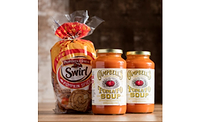Protein, sustainability and “functional foods” are among the top food trends for 2017, according to a new report from the International Food Information Council (IFIC) Foundation.
Using a combination of in-house survey research, health professional expertise and other data, the IFIC Foundation identified nine food and nutrition trends it expects to be hot topics in 2017.
1. A Functional Place for Foods
Functional foods are foods with health benefits beyond basic nutrition, such as weight loss or digestive health. In the IFIC Foundation’s 2016 Food and Health Survey, nearly half of consumers said that "weight loss/management" is a health benefit they are interested in getting from foods. About one-third of Americans listed "increased energy," "cardiovascular health," "healthy aging," or "digestive health."
Google listed "Food with a Function" as one of its top five food trends in 2016. Among the functional foods and ingredients often searched for were turmeric, jackfruit and kefir.
2. A "Healthy" Debate
With changes to nutrition labels over the past several years, healthy information has become more important. The Food and Drug Administration is currently redefining healthy nutrition claims on package labels.
More than a third of respondents to the 2016 IFIC survey said that healthy food is defined in part by what it does not contain, rather than what it does contain. Organic certification and absence labeling changes to Nutrition Facts labels over the past several years fit in with that idea.
3. The Acceptability of Sustainability
Sustainability is touching all aspects of consumers’ lives, and food and beverage purchasing decisions are no different. The 2016 Food and Health Survey found that 41 percent of consumers listed it as a factor in their decisions. That’s up from 35 percent in 2015, and it marks the largest increase in the number of people who say sustainability is a factor since the question was first asked in 2011. About 75 percent of respondents say it’s important for food to be produced in a sustainable way.
But, cost still affects the adoption of sustainable foods. Only 38 percent of consumers say they would be willing to pay more for sustainably produced foods and beverages.
4. Protein Still a Powerhouse
One constant result from the Food and Health Survey has been that Americans view calories from protein as the least likely to cause weight gain, and it’s no different this year. Almost two-thirds of respondents say they’re trying to consume more protein or as much as possible. That’s up from 54 percent in 2015 and 50 percent in 2014.
About 20 percent of people view plant protein as more healthful than they did in 2015, while 8 percent consider it less healthy. Views on animal protein were more balanced, with 12 percent viewing it as more healthful than the year before and 15 percent seeing it as less healthful.
5. Whole Grains Gaining; Pasta Staging a Comeback?
Dietary guidelines recommending more whole grains are getting the message across. Almost 60 percent of Americans are trying to have more whole grains in their diet, up from 56 percent in 2015 and 53 percent in 2014.
Interest in pasta is mounting a comeback, although it’s unknown if it’s directly connected to the increased consumption of whole grains. Google cited pasta as one of its top five food trends in 2016.
6. CRISPR Coming of Age
CRISPR (clustered regularly interspaced short palindromic repeats) is a form of biotechnology that edits an organism’s own genes in a highly targeted way, rather than splicing in genes from other organisms (or transgenics).
The U.S. Department of Agriculture has determined that it does not need to approve individual applications of CRISPR technology, because transgenics are not involved. CRISPR also avoids some of the common stigmas of biotechnology by not splicing in genes from other organisms.
But, about a third of respondents to the Food and Health Survey say they still need more information about biotechnology to make an informed decision about its role in their food purchasing decisions. Less than a quarter say biotechnology should not be involved at all in food production.
7. Coffee Is on Solid "Grounds"
Coffee is already America’s favorite hot beverage, and there are no signs of its demand slowing in 2017. Demand for coffee in the U.S. is growing far more quickly than in other markets.
Much of the growth is being driven by the Millennial generation. Also contributing are new ways to consume coffee, such as cold brew or in recipes.
Americans also appear to be more knowledgeable about their caffeine intake, according to the 2016 Food and Health Survey, with 69 percent stating that they know how much caffeine they consume — up significantly from 64 percent in 2015 and 63 percent in 2014.
8. We’re Still App-Happy
About 22 percent of respondents say they use an app or other means to track their daily food and beverage intake, as well as its healthiness. That’s double the number from the year before.
That number could well increase in 2017, as apps continue their rapid growth. An estimated 269 billion apps will be downloaded in 2017, which would be double the number from three years ago. Screen time on desktops and laptops continues to decline, while the amount of time spent on mobile devices continues to grow.
9. Weight Loss Making Gains
The 2016 Food and Health Survey showed glimmers of hope in America’s showed that 57 percent of Americans are trying to lose weight. That’s up from 52 percent in 2015. The number of people trying to maintain their current weight fell from 29 percent in 2015 to 23 percent in 2016.
In addition, according to the survey, the number of overweight and obese Americans (as judged by BMI) fell to 60 percent in 2016 from 64 percent in 2015.
The IFIC Foundation’s full 2016 Food and Health Survey findings and additional information are available on the Foundation’s website: http://www.foodinsight.org/2016-FHS. The 2017 Food and Health Survey is scheduled for release in May.








